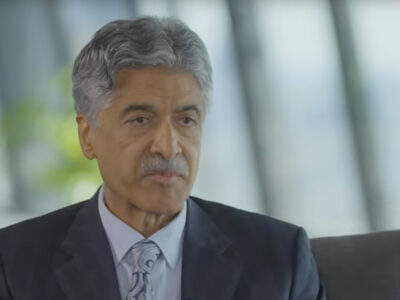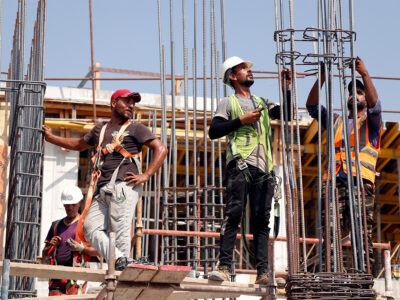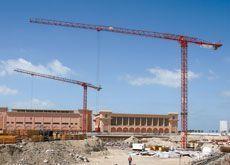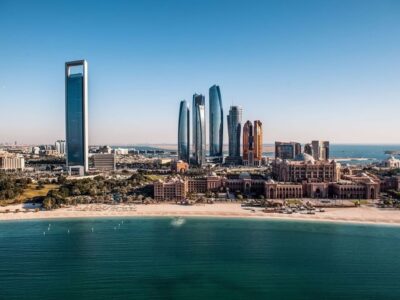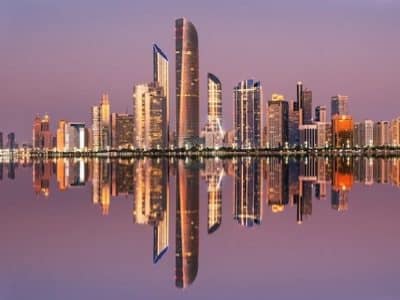Greg Whitaker looks at a crane anti-collision system in operation.
Let’s face it; building sites are generally pretty grim places to work. A bleak landscape with heat, dust and occupational hazards are quite the industry norm out here. While there is little that can be done about the heat and the dust, the other aspects are a little better on the site that CW is
visiting today.
For one, the skyline is far from bleak, thanks to the ever-changing vista across the Arabian Gulf, but more importantly the workplace hazards have been reduced, thanks to a modern anti-collision system fitted to the tower cranes working on site.
To be fair, this site is hardly the most complex in terms of cranes. Five fixed-jib Korean units are working on the resort which will comprise of the main hotel block, shaped roughly like a ‘W’, with a further block on the back.
The rest of the development has half a dozen other buildings, plus various smaller structures, the shape of which is becoming apparent now that the formwork system is beginning to rise out of the ground.
Breakwater
The project itself is quite interesting. Situated on the breakwater of the Palm Jumeriah, next to the Atlantis Hotel, this is surely one of the most prime real estate sites in the world, whatever the economic climate. Mirk General Trading owns the local franchise of posh French hotel chain Sofitel and it has appointed Mirk Architectural and Engineering as the lead consultant and Evan Lim – Penta Construction as the main contractor.
Because the development is on the curved breakwater of the Palm, it is not completely symmetrical. Instead it resembles a kind of ‘curved oblong’ and as such the pattern that the cranes have been divided into meant that there are overlaps on each, as well as ‘no hoisting areas’, namely zones that the cranes are not permitted to slew into.
Working on separate structures at the same time, means that communication might not always be clear between teams, and as such the project manager took the decision to install an anti-collision system known as the AGS AC3.
Accuracy
Like most operations there is a need and an obligation to measure the wind speed accurately. This is why part of the system includes an anemometer, a device not dissimilar to the airflow meter on a car, and works similar in principle to an old fashioned weather vane. This is linked to a real-time display showing the wind speed, and a siren sounds and lights flash if this speed is exceeded. This is a fairly fundamental piece of kit on any tower crane, but the box sullied to the Sofitel site can be further enhanced with an orange flashing beacon and a very loud 115db siren, in case the tower is being operated on the ground via remote. You can also have data links to a repeater or a repeater-recorder if needed.
If the site manager had so desired, a number of wireless cameras could also be linked in to this system. Obviously, the primary use is to lose ‘blind spots’ around the operator, but it can also be positioned above the winch to make sure that the cable is being wound correctly.
The AC3 system is comprised of a computer, and the crane itself is rigged with sensors ,which can determine things like the hook height, and the position of things like the position of the jib and counter jib of all the other cranes on site. As the cranes slew, an alarm is sounded if the booms get too close together. If no action is taken by the operator of one or both of the cranes, then the brake will be automatically applied.
There is another module available which will sound the alarms if the hook height drops below a certain point over the ‘no hoisting’ areas. This, understandably is to prevent members of the public from getting bonked on the head by a crane hook.
Of course, hi-tech cranes are always useful on a job site, but they do not build the whole structure of course.
On the Sofitel site, a number of smaller mobile cranes belonging to subcontractors are also in use to sling items around. The heavy excavators have moved out, but there are still a couple backhoe loaders for lighter trenching and loading jobs.
Apart from that, the site is alive with the hustle and bustle of a busy construction site – which itself is nice to see in the current financial climate.
Whatever the season, the site is in a good spot, so hopefully the collision-proof cranes will continue until the structure is finished. With crane safety still a serious concern around the region, it is hoped that similar safety systems will find their way on to other sites in the region soon.
There are dozens of anti collision systems on the market, and different experts will give you different opinions on different types. Shata M , a safety consultant, and a member of the UAE’s crane safety forum suggested that the AGS system mentioned in the article is the best all round kit. Other types are available, but he points out that ‘not all systems are compatible with every tower crane’. He advised checking the systems carefully and seeking independent advice before committing.
